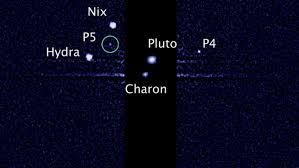Overview
The dwarf planet Pluto is more than 5.8 billion kilometers away from the Sun, about 40 times the distance between the Earth and the Sun. Its largest moon, Charon, is about half its size. From the time it was discovered in 1930 to 2006, Pluto was called the ninth planet in the Solar System. However, in 2006, astronomers reclassified it as a dwarf planet because of features of its orbit and its small size.
Characteristics of Pluto
Pluto is made of rock and ice. Its brightness and even its color varies, from black to orange to white. It is about 1/6 the mass of the Moon, and 1/3 its volume. It may have a rocky core surrounded by a mantle of water ice, methane ice, and carbon monoxide ice. It is more similar to the rocky moons of Jupiter, Uranus, and Neptune than to other planets in the Solar System. A thin atmosphere of nitrogen, methane, and carbon monoxide surrounds Pluto. A Plutonian year is 248 Earth years long, its average temperature is about -230°, and it takes about 6 ½ days for the planet to rotate.
Moons of Pluto
Pluto and its largest moon Charon orbit around a fixed point, leading some astronomers to call the system a dwarf double planet. Pluto and Charon also are tidally locked, so they present the same face to each other. Charon is nearly half the size of Pluto, and may have ice geysers of ammonia erupting from its surface. Observations from the Hubble Space Telescope show four smaller moons, named Nix, Hydra, Kerberos, and Styx.
Controversy over Pluto
The search for “Planet X” beyond Neptune began in the early 20th century, shortly after Neptune itself was found. Scientists carefully compared their predictions of where things should be on the astronomical charts with their observations of objects. An astronomer named Clyde Tombaugh discovered a planet in 1930 that was much smaller and farther away than Neptune. Even though the object was in the right place, it was much smaller than it should be. In 2006, the International Astronomical Union formally defined the characteristics of a planet as in orbit around the Sun, is large enough to become spherical, and has swept other bodies from its orbit. Pluto is in orbit around the Sun, although its orbit is more highly elliptical and at an angle to the other planets. It is smaller than the other planets, as well as some satellites. Also, the Hubble Space Telescope and other long-range observatories have discovered several other objects about the size of Pluto that are in the same vicinity, beyond the orbit of Neptune.
Exploration of Pluto
Pluto is very small and far away, so it is only visible by telescope. Most discoveries about Pluto have been through observations by the Hubble Space Telescope, such as its surface features, atmosphere, and moons. The New Horizons mission was launched in 2006. The probe is now approaching Pluto and will make its closest flyby in July 2015. The most recent observations show possible jets of carbon dioxide ice evaporating from its polar caps.
Interested in science tutoring services? Learn more about how we are assisting thousands of students each academic year.
SchoolTutoring Academy is the premier educational services company for K-12 and college students. We offer tutoring programs for students in K-12, AP classes, and college. To learn more about how we help parents and students in Los Lunas, NM: visit Tutoring in Los Lunas, NM



